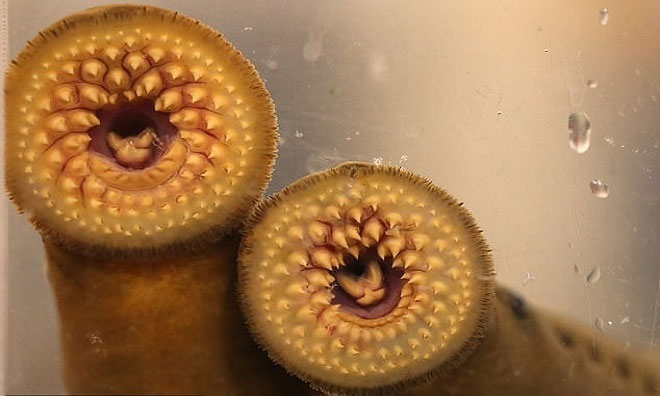'Vampires' fish invade the lake
An invasive species of rockfish are breeding in a freshwater lake in the state of Vermont, hundreds of kilometers away from their natural habitat.

Rockfish , also known as the "vampire fish", exist by parasiting on other fish, clinging to the host's body to suck blood and body fluids. The Vermont State Fish and Wildlife Service (VFW) says that the rockfish is becoming an invasive species in the state's Lake Champlain near the Canadian border. Another lesser species of rockfish is widely distributed throughout the state, especially in the Connecticut River and its tributaries.

Stone fighting fish suck blood from the host. (Photo: Toronto Star).
The state government says that unlike the Champlain lake caves, river lout is not a real threat to other fish, and even plays an important role in maintaining the ecosystem. "If you see rockfish laying their eggs or their carcasses, don't panic. This fish provides many ecological benefits and is considered a conservation species in both Vermont and New Hampshire," said Lael Will, home. Biologist at VFW, said.
Giant barramundi spawn in large numbers in the spring every year, but most die shortly after spawning. Their decomposition provides food for other aquatic animals and birds in the area. Young rockfish can spend 5 years in a calm state, burrowing beneath the sand in the river bed and filtering small particles of food in the water. After reaching adulthood, they swim downstream into the Atlantic, spending the rest of their life sucking other species' blood.
In the past, fighting catfish used to contribute to the destruction of the freshwater fish population. A fighting rockfish can destroy an average of 18kg of fish a year. An invasion of rockfish in the Great Lakes region almost wiped out the regional salmon industry, causing losses of 6.8 million kilograms of fish in the 1940s and nearly 137,000 kg in the early 1960s. Control measures include placing barricades in the river to prevent rockfish swimming upstream or trapping chemicals that kill larvae without harming other species.
- The extremely poisonous lion fish is invading the Atlantic
- 'Sea vampires' suck up the blood of their prey
- 'Vampires' in Myanmar
- Hunt vampires in New England
- West Lake management board: 'Many dead fish may be due to weather changes'
- Vampires in the animal world
- The sentence is 'freakish' in West Lake
- Algae invade the deepest lake in the world
- The largest freshwater lake in Baikal in the world is seriously damaged
- The truth about the origin of vampires
- The 200m-wide lake disappeared without a trace after a night
- Dark history of vampires
 Animal 'suffering' after hibernation
Animal 'suffering' after hibernation Why do goats climb well?
Why do goats climb well? Scientists were surprised to see chimpanzees eating turtles
Scientists were surprised to see chimpanzees eating turtles Giant catfish died deadly due to drought in Thailand
Giant catfish died deadly due to drought in Thailand